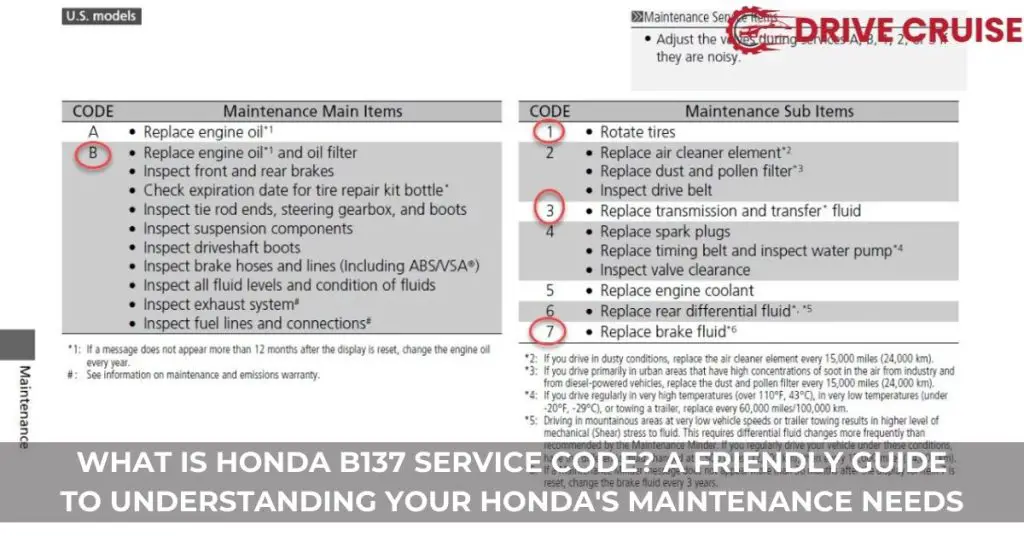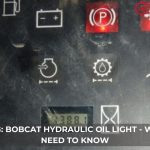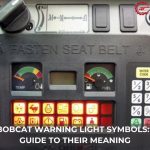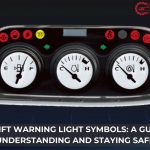Ever found yourself scratching your head at the sight of a service code on your Honda’s dashboard? You’re not alone. Service codes, like the mysterious B137, can often seem like cryptic messages from our vehicles, urging us to decipher them. But worry not, we’re here to shed some light on what this particular code means for your Honda.
The B137 service code is more than just a random assortment of letters and numbers—it’s a call to action for specific maintenance tasks that are crucial for keeping your car running smoothly. Understanding what this code signifies can save you time and money, and ensure that your Honda stays in top-notch condition. Let’s dive into the world of Honda service codes together, starting with the ins and outs of B137.
Understanding Honda B137 Service Code
Navigating the world of Honda service codes, especially the B137 code, is crucial for maintaining your car’s health. These codes, appearing on the dashboard, guide us toward specific maintenance actions. Here, we dive into the meaning of the B137 service code and what it signifies for a Honda owner.
The B137 service code is a multifaceted indicator, signaling three main maintenance tasks:
- Brake Inspection (B): This part of the code suggests a thorough check of the brakes. Brake inspections are vital for safety, ensuring all components, like pads, discs, and fluid, are in good condition.
- Replace Engine Oil and Filter (1): Regular oil changes are foundational to a car’s longevity. This part of the code indicates it’s time to replace the old oil and filter, helping the engine run smoothly and efficiently.
- Tire Rotation (7): Tire rotation is essential for even tire wear, contributing to better handling and longer tire life. This segment of the code reminds us to rotate the tires, promoting a balanced drive.
Reacting to these indicators does more than keep your car in excellent condition; it also prevents future repair costs and ensures the vehicle operates efficiently. Ignoring the B137 service code can lead to diminished performance, increased wear on parts, and potentially more significant issues down the line.
By adhering to the maintenance schedule the B137 code represents, we extend the lifespan of the vehicle, maintain its performance, and ensure it remains a reliable mode of transportation. It’s these proactive steps that help avoid breakdowns and costly repairs, reassuring us that our Honda is in top shape. Understanding and acting on the B137 service code is a straightforward way to contribute to the overall well-being of your Honda, ensuring it serves you well for miles to come.
Components of the B137 Service
Having talked about the vital role Honda service codes play in maintaining your vehicle’s health, let’s dive deeper into the specific components of the B137 service code. This code isn’t just a random assortment of letters and numbers; it’s a critical reminder for specific maintenance tasks that are key to keeping your Honda running smoothly.
First and foremost, the “B” in B137 refers to a series of inspections and a possible oil and oil filter replacement. It’s not just about swapping out old oil for new, though. This step ensures that your engine remains in top condition, free from contaminants that can affect its performance and longevity. The oil filter, equally important, helps to sift out debris before it can cause harm.
The “1” in the sequence signifies tire rotation. Regular tire rotation is paramount in promoting even tire wear, which, in turn, extends the lifespan of your tires. Even wear helps maintain better traction on the road, which means safer driving conditions for you and your passengers.
The “3” and “7”, often overlooked, are crucial as well. “3” stands for the replacement of the transmission fluid, a key component in keeping your vehicle’s gearbox operating efficiently. Properly maintained transmission fluid ensures smoother gear shifts and can significantly extend the life of your vehicle’s transmission.
Lastly, the “7” indicates a brake inspection. This involves checking the brakes for wear and tear, ensuring that all components are in good working order. It’s a vital step in maintaining the safety of your vehicle, as well-functioning brakes are critical for preventing accidents.
The B137 service code is a comprehensive package designed to address several key areas of your Honda’s maintenance. Each component, from oil change to brake inspection, plays a vital role in ensuring your vehicle operates safely, efficiently, and reliably for years to come. By adhering to this service code, we can help prevent future repair costs, ensure better vehicle performance, and ultimately contribute to the longevity and reliability of your Honda.
Importance of Addressing the B137 Service Promptly
Addressing the B137 service code promptly ensures the safety, efficiency, and longevity of Honda vehicles. By following the service schedule for oil and filter changes, tire rotation, transmission fluid replacement, and brake inspections, we effectively maintain the vehicle’s performance and reliability. Ignoring these maintenance tasks can lead to significant issues down the line.
Firstly, regular engine oil and filter replacements keep the engine running smoothly, minimizing wear and tear. Fresh oil lubricates the engine components effectively, reducing friction and preventing overheating. When we delay this service, the oil becomes thicker and less effective, causing the engine to work harder, compromising performance, and increasing fuel consumption.
Secondly, tire rotation is vital for even tire wear. It ensures that all tires wear down uniformly, extending their lifespan and maintaining the vehicle’s handling. Neglecting tire rotation results in uneven tire wear, leading to poor performance, reduced fuel efficiency, and potentially hazardous driving conditions.
Additionally, transmission fluid plays a crucial role in the operation of a Honda vehicle. It lubricates the transmission’s moving parts, preventing overheating and unnecessary friction. Without timely replacement, the transmission could suffer from increased wear, leading to costly repairs.
Brake inspections are equally important for safety. These checks ensure that the braking system is in optimal condition, providing peace of mind that the vehicle can stop effectively when needed. Delaying brake inspections and necessary maintenance can compromise the vehicle’s braking capability, putting the driver and passengers at risk.
Promptly addressing the B137 service code is indispensable. It not only prevents future repair costs but also enhances the vehicle’s performance, ensuring a smoother and safer driving experience. Our commitment to following the Honda service schedule maintains our vehicle’s integrity, proving invaluable over time.
How to Reset the Honda B137 Service Code
After addressing the maintenance tasks associated with the Honda B137 service code, resetting the service light is the next step to ensure your vehicle’s onboard computer correctly tracks when the next service is due. Let’s guide you through the straightforward process.
First, turn your engine off and ensure the ignition is in the “off” position. Next, press and hold the odometer button, found on the dashboard near the speedometer. While holding the odometer button down, turn the ignition switch to the “on” position. However, don’t start the engine. After a few seconds, the vehicle’s system will enter the reset mode, indicated by the service light flashing.
Continue to hold the odometer button until the service light turns off. Once the service light turns off, release the button. This indicates the system has successfully reset the service code. To confirm, turn the ignition off and then on again. The service light should not appear if the reset was successful.
If the service light remains on, it might suggest an issue wasn’t fully addressed, or the reset process needs another attempt. Ensure all maintenance associated with the B137 code, such as brake inspection, engine oil and filter replacement, tire rotation, and transmission fluid replacement, is properly completed before trying to reset the code again.
Addressing these maintenance tasks and resetting the service code not only contribute to the safety, efficiency, and longevity of your Honda but also maintain its performance and reliability. By following the service schedule and resetting the service codes as required, you’ll help avoid costly repairs and ensure a smoother and safer driving experience over time.
Cost Implications of the B137 Service
Understanding the cost associated with the B137 service is crucial for Honda owners, as it gives a clear picture of what to expect financially. The B137 service includes multiple maintenance tasks that, when combined, contribute significantly to the vehicle’s longevity and reliability. Each component of this service plays a vital role in ensuring the smooth operation of the vehicle, but also adds to the overall cost.
The primary services under the B137 code include brake inspection, engine oil and filter replacement, tire rotation, and transmission fluid replacement. The cost for these services can vary widely based on several factors such as location, dealership, and whether any additional issues are discovered during the service that may require attention.
- Brake inspection usually incurs minimal charges, unless it reveals the need for new brake pads or rotors, which can significantly increase the cost.
- Engine oil and filter replacement is generally an affordable service, costing between $35 and $75. Honda vehicles specifically might be on the higher end of this range, depending on the type of oil used.
- Tire rotation can cost anywhere from $20 to $50. This service ensures even wear on all tires, extending their life and saving money in the long run.
- Transmission fluid replacement is the most variable, typically ranging from $80 to $250. For Honda vehicles, using the correct transmission fluid is crucial and can affect the cost.
In total, the B137 service can cost between $135 and $400, taking into account the potential for additional repairs or replacements identified during the service. Owners should also consider the long-term benefits of addressing the B137 code promptly. Regular maintenance helps avoid major repairs down the line, which could far exceed the cost of the B137 service. Engaging with authorized Honda service centers or trusted mechanics who specialize in Honda vehicles ensures that the car receives the best care possible, maintaining its performance and reliability over time.
Consumer Experiences with B137 Service
Transitioning from the importance of addressing the B137 service code, we find that consumer experiences with this specific service are largely positive. Many Honda owners recount how timely completion of the B137 service has significantly enhanced their vehicle’s performance. For instance, after the engine oil and filter replacement, users frequently notice smoother engine operation and improved fuel efficiency. Similarly, following brake inspections and potential maintenance, the responsiveness and safety of the braking system often exceed expectations.
Tire rotation, another component of the B137 service, contributes to the extended lifespan of tires. Honda owners report reduced uneven tire wear, which not only saves money on early tire replacement but also maintains optimal vehicle stability and handling. Moreover, the replacement of transmission fluid as part of the B137 service ensures that the vehicle’s gearbox operates efficiently, with many consumers observing a noticeable difference in transmission smoothness and responsiveness after the service.
Cost-wise, while the initial outlay for B137 service might seem substantial, ranging from $135 to $400, customers emphasize the long-term savings. They highlight how investing in regular B137 services minimizes the risk of costly repairs or replacements down the line. Encounters with authorized Honda service centers are usually described as satisfactory, with the professionalism and expertise of technicians often praised. Customers appreciate the thorough explanation of service details and the transparent breakdown of costs provided by service advisors.
The consensus among Honda owners is clear: the B137 service is a worthwhile investment in their vehicle’s longevity and reliability. The peace of mind that comes from knowing their vehicle has undergone comprehensive maintenance, along with the immediate improvements in performance and safety, makes the B137 service highly recommended among the Honda community.
Conclusion
We’ve walked through the ins and outs of the Honda B137 service code and its undeniable importance in maintaining our vehicles. It’s clear that investing in such comprehensive maintenance not only secures our car’s performance but also its safety and longevity. The cost, while varying, is a small price to pay for the peace of mind and the long-term savings from avoiding more serious repairs down the line. Our experiences, alongside those of countless other Honda owners, affirm the value of trusting in professional care for our cars. Let’s keep our vehicles running smoothly and efficiently, ensuring we’re always ready for the road ahead.
Related Posts:
- What is Honda A1 Service Code and How to Understand It
- What is Honda A13 Service Code: A Friendly Guide
- What is Honda A15 Service Code? A Friendly Guide to Understanding It
- What is Honda A123 Service Code? A Friendly Guide to Understanding Honda Maintenance Codes
- What Is Honda A137 Service Code? Your Quick Guide to Understanding It
- What is Honda B12 Service Code: A Friendly Guide
- What is Honda B123 Service Code? A Friendly Guide to Understanding Maintenance Codes
- What is Honda B125 Service Code: A Beginner’s Guide
- What is Honda B135 Service Code? A Friendly Guide to Understanding It
- What is Honda B137 Service Code? A Friendly Guide to Understanding Your Honda’s Maintenance Needs







